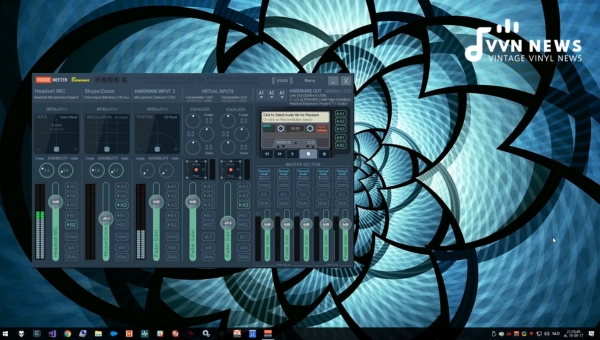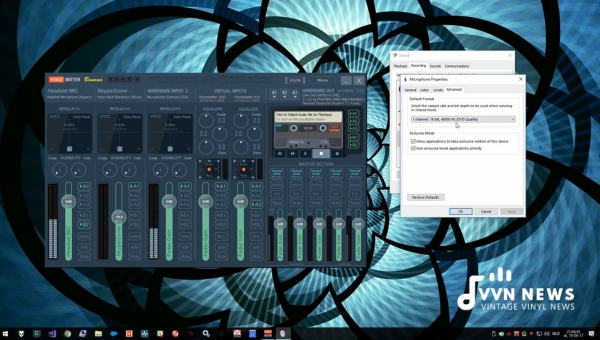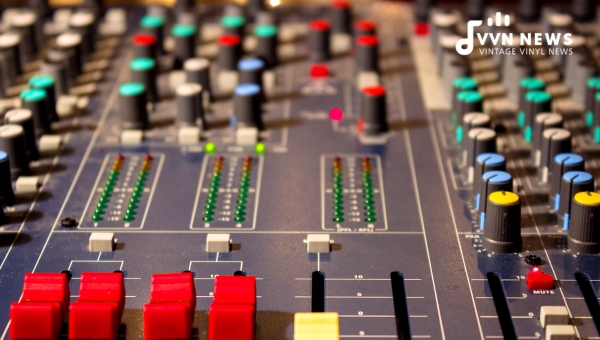Recording audio is an art form. It requires a blending of technology with creativity and technical command. But even the most talented artists can be impeded by the nuisance known as latency.
Many have asked how to achieve low audio latency while recording. Well, you’re in luck because that’s exactly what I’ll be shedding light on today.
In layman’s terms, latency is simply a delay—a lag between a system’s input and output. In the world of recording, it is the time between singing into your mic, playing an instrument, or dropping a mean beat on your drum pad—and when you hear it back through your speakers or headphones.
The goal is to reduce this delay to the barest minimum. Together, we will eradicate the crippling effects of latency from your recording sessions forever.
What is Audio Latency?
Audio latency is the measurable delay from when an audio signal enters a system to when it emerges. It essentially refers to a short delay (usually measured in milliseconds) between an audio signal entering and emerging from a system.
Factors affecting latency include analog-to-digital conversion, buffering, data transfer, decoding, and output.
In an optimal setup, this latency is not noticeable and does not affect the listening experience.
However, excessive audio latency can cause significant issues in live broadcasting or music production environments.
When it comes to digital audio systems, the number one nemesis for anyone – be it musicians, content creators, or broadcasting pros – is high latency.
Audio latency may be microscopic regarding actual time-lapse (usually measured in milliseconds), yet even this tiny gap can create big headaches by causing noticeable delays, significantly impairing recording quality.
What Causes High Audio Latency in Recordings?

Given the technological intricacies involved in recording, several factors can contribute to high audio latency.
It is crucial to understand each one to effectively troubleshoot and keep your audio flow as smooth as silk.
Hardware Limitations
Audio latency often finds its roots in hardware limitations. The audio interface you’re using plays a pivotal role here.
For instance, older or low-end models may lack the necessary speed or processing power to handle large amounts of digital information in real time, resulting in higher latency.
External factors, such as the quality of your cables and connections, can also impact latency.
Damaged or low-quality cables might hinder data flow, causing delays. Even something seemingly trivial, like the length of your rope, can affect latency – longer lines can potentially result in higher latency times.
Also Read: How To Use Music To Help Your Mental Health? [Expert Tips]
Software Incompatibilities
Moving beyond hardware restrictions, certain software-related issues can induce high audio latency when recording, especially software incompatibilities.
Your computer’s operating system and Digital Audio Workstation (DAW) must work harmoniously for optimal performance.
Each DAW behaves differently, depending on factors such as its design and complexity of features.
If your current DAW doesn’t play well with your OS or other installed applications, it may result in unanticipated delays during recording sessions.
Network Congestion
Another culprit behind high audio latency is usually network congestion. This comes into play particularly while employing network-based systems for recording sessions.
Just as traffic backups hinder highway movement, high data transmission volumes over networks can cause delays and elevated latency levels.
This is further exacerbated when there aren’t enough resources to manage said traffic – due to simultaneous usage by multiple users/devices or substantial loads from hefty file sizes being moved across networks.
Incorrect Settings
Even with premium hardware and perfectly harmonious software, incorrect settings can throw a wrench into the works, resulting in high audio latency.
It could be a matter of inadequate buffer settings on your DAW or incorrect driver configurations on your interfaces that keep them from functioning at their best capacity.
Understanding the causes behind more significant latency during audio recordings is primarily about realizing how every piece of this multilayered puzzle fits together – then checking every corner for potential glitches!
Even though we’re dealing with technology here – where perfection is likely an arduous pursuit – armed with knowledge about these core issues hindering optimal performance should set you well on track toward achieving lower audio latencies.
Importance of Achieving Low Latency in Audio Recording
We strive to attain low latency during audio recording, not merely for the thrill of overcoming a technical challenge.
Several crucial aspects accentuate its importance:
Enhanced Sound Quality
By achieving low latency, we can vastly enhance the overall sound quality in an audio recording.
When you can deliver your audio signal without observable delay, it results in a smoother, cleaner sound playback.
High latency may lead to audible artifacts, like pops and clicks, or noticeable delay echoes that may ruin your pitch-perfect performance.
Real-time Playing Experience
The recording experience should feel as accurate as possible for musicians and performers.
Just imagine – you’re laying down a guitar track while humming along with it, but there’s a pesky delay between what you play and hear!
It’s not just annoying; it can add up to seriously throw off your timing and rhythm, rendering the entire session fruitless.
Achieving low latency allows for an authentic real-time playing experience, offering immediate feedback to musicians during recording sessions.
You hear it instantly through your speakers or headphones when you strum a chord or hit a drum.
Also Read: How To Clean Your Flute [Keep Your Instrument Shiny & Sounding Great]
Sources of Latency

Audio Interface Latency
Audio interface latency refers to the delay caused by the conversion process in audio interfaces. When you are recording sound, it goes through an analog-to-digital converter and a digital-to-analog converter.
The conversion introduces a gap known as audio interface latency between entering your microphone (or instrument) and coming out from your speakers or headphones.
Moreover, audio interfaces have buffers – small data storage spaces where digital information is temporarily held before processing.
When these buffers are large, more data can be processed at once, but larger buffers mean longer processing time— contributing to inviting our undesired guest: latency.
Device/Plug-in Related Latency
Every device or plugin we use for recording contributes to latency in one way or another, hence named device/plug-in-related latency.
For instance, plugins used for signal processing like compression, equalization, or reverb contribute to latency because they require processing time.
The higher the number of plugins involved in an audio route and the more complex they are, the longer it takes for sound to travel from origin to destination.
Similarly, devices like MIDI controllers and synthesizers contribute to latency, especially when they require complicated signal routing or include built-in effects.
It should also be noted that not all plugins report their latency correctly, making troubleshooting more difficult.
In addition, using an old device with a new system can increase device-related latency due to increasing compatibility challenges between them.
How to Achieve Low Audio Latency
Managing audio latency can seem daunting, but with the following five tips, you’ll be well on your way to achieving low audio latency.
Optimize Buffer Settings
One of the most effective ways to reduce audio latency is by tweaking your buffer settings.
Your buffer size controls how much data your system processes at a time. As I lower my buffer size, it processes less data, resulting in low latency.
This has its downside: if the buffer size is too low, your computer might not handle it and could produce clicking or popping sounds due to ‘buffer underrun.’
Hence, optimizing these settings according to your device’s capability is essential.
To control these settings in DAWs, you often find them under the preferences or audio set-ups option.
Adjust Buffers in Various Phases
About optimizing buffers, understanding the various phases where buffers impact latency can be helpful.
- Record Enable Buffer: Certain software allows reducing the buffer size when recording tracks for better real-time feedback.
- Playback I/O Buffer: The playback I/O buffer influences just playback tracks. Using a larger setting here allows more CPU but results in higher latency.
- Low Latency Monitoring: Some digital workstations have this feature where they disable plugin processing while recording, which significantly reduces the overall path length and hence aids in achieving optimal latency reduction
Track Freezing
Track freezing is another beautiful feature you must utilize. “Freezing” a track will render it as an audio file and temporarily release its demands on your CPU – reducing the load and indirectly improving latency.
Although frozen tracks don’t allow editing (since they’re pre-rendered), using this while fine-tuning other project areas can help reduce lag and speed up your workflow.
Employ Direct Monitoring
Direct monitoring allows you to listen to input signals directly from hardware such as microphones or musical instruments, bypassing software-induced delay.
This approach gives you zero-latency monitoring, but beware! Since it bypasses software processing, you won’t be able to hear any effects applied through DAWs until after recording.
Maintain Updated Drivers
Drivers are the software operating systems used for communication with hardware devices like sound cards or audio interfaces.
Outdated drivers might struggle with newer versions of other connected applications, leading to higher latencies that hamper recordings.
Armed with these insights and tips now, I hope tackling high audio latencies will seem less dreadful than before!
Tune those settings, freeze those tracks where necessary, explore direct monitoring when feasible—and keep those drivers up-to-date.
Also Read: How Much Should You Charge For Music Lessons? [Fair Rates Guide]
Essential Tools for Reducing Audio Latency

Achieving low latency is not a light job; it requires investing in the right tools.
Here’s a deep dive into some essential tools that can help you achieve low audio latency.
Selecting the Right Audio Interface
The audio interface is paramount in your quest for low latency.
Think of it as a conduit that carries sound from your microphone, instrument, or mixer into your computer.
A powerful audio interface equates to lower latency readings.
When assessing interfaces, look for one that boasts low round-trip latency – this figure often indicates how quickly the interface can process audio data.
Other key considerations include the number of inputs/outputs and compatibility with your computer’s operating system.
Notable mentions include Focusrite Scarlett, known for its low latency, and PreSonus AudioBox, renowned for its seamless integration with DAWs.
Utilizing Digital Audio Workstation Software (DAW)
DAWs, or Digital Audio Workstations, are at the epicenter of today’s recording process.
These software applications allow you to record, edit, mix, and master audio tracks within one platform.
Optimization of DAW settings can hugely impact latency levels. Two crucial settings are buffer size and sample rate.
A smaller buffer leads to lower latency but may cause clicks or glitches if it’s too small for your computer to handle.
Similarly, a higher sample rate means better quality audio and higher latency as more data is processed simultaneously.
Pro Tools and Ableton Live are among DAWs acclaimed for their efficient buffering handling and easy-to-use options to manage sampling rates.
Need for a Well-Equipped Computer
Finally, never overlook the need for a well-resourced machine underpinning your recording setup.
Your computer must handle numerous tasks simultaneously during recording sessions – like processing inputs from multiple microphones or feeding signals to monitors and headphones– all while running resource-intensive DSP effects processing plugins in real time!
I recommend a system with an up-to-date processor (Intel i5 or above), ample memory (8GB minimum), and an SSD hard drive to access data files swiftly.
FAQs About audio latency
What is audio latency?
Audio latency refers to the small delay from when sound is created—when you hit a note on your keyboard—to when it’s processed and played back through your speakers or headphones.
Why is low audio latency important?
Low audio latency ensures instantaneous feedback. For musicians, this means they can play instruments or sing in real-time without hearing a noticeable delay, resulting in a smoother recording experience.
How does buffer size affect audio latency?
Larger buffer sizes can increase audio latency because the system takes longer to process more extensive data. By lowering buffer size, you can achieve lower latency, but remember that this also requires more computational resources.
Can software updates help reduce audio latency?
Absolutely! Keeping your drivers and digital audio workstation (DAW) software up-to-date can help reduce audio issues, including latency. Updated drivers and software often include performance improvements and bug fixes.
Can higher-end hardware mitigate the effects of audio latency?
Better quality or professional-grade hardware like sound cards or an advanced audio interface can drastically reduce audio latency. The higher processing power of these devices enables quicker data processing, leading to lower latency.
Conclusion
Achieving low audio latency while recording isn’t an impossible feat. It requires effective use of hardware and software settings and advanced techniques like direct monitoring and track freezing.
Exploiting these methods appropriately will improve your audio recording quality, providing a seamless working environment for all your audio projects.
Latency is another challenge to overcome in sound recording to unleash your creativity!








